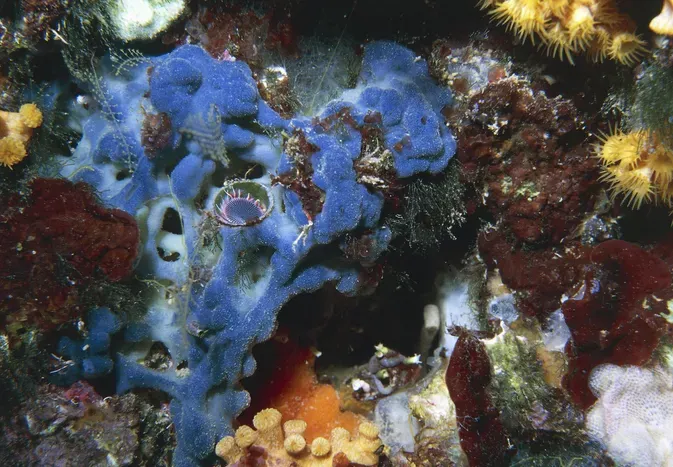Aquarium Red Slime Algae Causes and Solutions
Updated on 04/26/24

Red Slime Algae: The Bane of Marine Aquariums
As a dedicated marine aquarium enthusiast, you've likely encountered the dreaded red slime algae, a persistent foe that can wreak havoc on your underwater paradise. This post delves into the causes and solutions for red slime algae, empowering you with the knowledge to eliminate this nuisance and restore the pristine beauty of your aquarium.
Understanding Red Slime Algae
Red slime algae (also known as cyanobacteria or blue-green algae) is a photosynthetic bacterium that thrives in nutrient-rich marine environments. It manifests as a thick, slimy layer that covers surfaces in your aquarium, including rocks, decorations, and even corals. While it may appear reddish-brown or green, the presence of chlorophyll gives it a characteristic reddish hue.
Causes of Red Slime Algae
Identifying the root cause of red slime algae is crucial for effective treatment. Common causes include:
* High nutrient levels: Excess nitrates and phosphates in the water column provide ideal conditions for red slime to flourish.
* Insufficient water flow: Poor circulation allows algae to accumulate on surfaces.
* Inefficient filtration: A malfunctioning or undersized filtration system fails to remove algae spores and debris.
* Overfeeding: Uneaten fish food and organic matter decompose, releasing nutrients that fuel algae growth.
* Lack of competition: The absence of algae-consuming organisms, such as snails or herbivorous fish, allows red slime to dominate.
Solutions to Eradicate Red Slime Algae
Combating red slime algae requires a multifaceted approach that addresses the underlying causes. Key solutions include:
Nutrient Reduction:
* Perform regular water changes to reduce nutrient levels.
* Use phosphate removers and nitrate-reducing bacteria to supplement water changes.
* Adjust feeding schedules to minimize uneaten food.
Increased Water Flow:
* Ensure sufficient water circulation by adding powerheads or wavemakers.
* Direct the water flow towards affected areas to prevent algae accumulation.
Improved Filtration:
* Clean or replace filter media regularly to remove algae spores.
* Consider upgrading to a more powerful or efficient filtration system.
Biological Control:
* Introduce algae-eating animals such as snails, hermit crabs, or certain fish species that feed on red slime.
* Encourage the growth of beneficial bacteria that compete with red slime for nutrients.
Chemical Treatment (As a Last Resort):
* Use Erythromycin or Maracyn antibiotics specifically designed for treating red slime algae.
* Follow manufacturer's instructions carefully, as antibiotics can be harmful to aquarium inhabitants.
Preventive Measures:
* Maintain a stable and healthy ecosystem with appropriate lighting, water temperature, and salinity levels.
* Quarantine new additions to prevent the introduction of red slime spores.
* Practice proper aquarium maintenance, including regular cleaning and replacing water.
Example Scenarios:
* Nutrient-Rich Environment: If your aquarium has consistently high nutrient levels, focus on nutrient reduction methods. Perform frequent water changes, use phosphate removers, and adjust your feeding schedule.
* Poor Water Circulation: If algae accumulation is localized, increase water flow by adding a powerhead or altering the existing water circulation pattern. Clean or replace clogged filter media to improve filtration efficiency.
* Overfeeding: Reduce the frequency and amount of food you provide to your fish. Remove uneaten food promptly to prevent nutrient buildup.
* Biological Imbalance: Introduce algae-eating organisms such as snails or herbivorous fish to control red slime growth. Encourage the growth of beneficial bacteria by providing suitable substrates and regular maintenance.
Conclusion
Red slime algae can be a persistent problem, but with a comprehensive understanding of its causes and solutions, you can effectively combat this nuisance and maintain a healthy and vibrant marine aquarium. By implementing a combination of nutrient reduction, increased water flow, improved filtration, biological control, and preventive measures, you can reclaim your underwater paradise from the clutches of red slime.
Explore More Pets

Freshwater Aquarium Filters
How to Deal With Cloudy Aquarium Water

Saltwater Aquarium Filters
How Do You Remove Chloramines From Tap Water?

Freshwater Aquariums & Habitat
Can I Keep My Koi Fish Inside?

Saltwater Aquariums & Habitat
14 Best Floating Plants for Your Aquarium

Freshwater Fish Health
How to Treat Ich on Freshwater Fish

Saltwater Fish Health
Fin Rot in Aquarium Fish

Freshwater Aquarium Filters
How to Do Aquarium Water Changes

Saltwater Fish Health
How Do Fish Get Parasites?